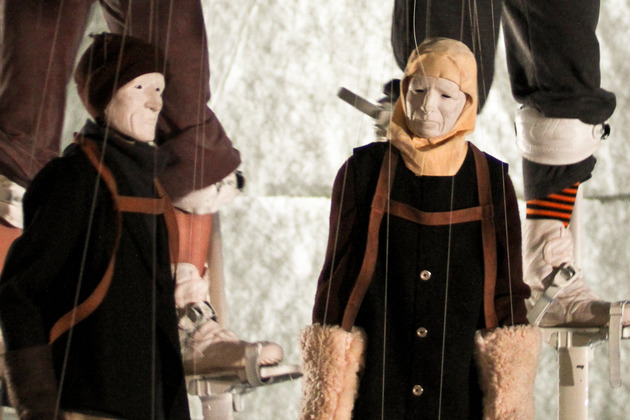Theater Review: Baby, It’s Cold Outside
By Debra Cash
69°S takes risks that never put actual life or limb in danger, but under the static of snow and history, we learn that venturing to the edge is always a kind of art.
69°S. [The Shackleton Project] by Phantom Limb with Skeleton Key. Presented by Arts Emerson at the Paramount Theatre, Boston, MA through February 12.
The pleasures of this snowless winter have been edged, for me, with disquiet about climate change. Nature acts, Voltaire once said, while human beings argue. But in 1914, the endless winter of Antarctica beckoned to British adventurer Ernest Shackleton. He published a newspaper employment notice that Arts Emerson director Rob Orchard calls “the pinnacle of truth in advertising”: “Men wanted for hazardous journey, small wages, bitter cold, long months of complete darkness, constant danger, safe return doubtful, honor and recognition in case of success.” Since the South Pole had already been claimed, the team would make the audacious errand of traverse the continent on foot. (And yes, it was just a few weeks ago that British skier Felicity Aston became the first woman to ski alone across Antarctica.)
69°S.[The Shackleton Project], the multimedia marionette show about the Endurance Expedition, was created by a huge, multidisciplinary team of collaborators under the direction of the New York based Phantom Limb company.
Led by visual artist Jessica Grindstaff and composer and puppet maker Erik Sanko, 69°S takes risks that never put actual life or limb in danger, but under the static of snow and history, we learn that venturing to the edge is always a kind of art.
69°S —the name comes from the latitude where Shackleton’s ship became trapped in pack ice and sank—is a dreamscape or perhaps a nightmare in nine vignettes. Snowscapes in ghostly video by Shaun Irons and Lauren Petty, lit exquisitely by Andrew Hill, shift like clouds against the back wall and play across luminous, triangular tents representing mountains and icebergs. Fragmentary images of cross-hatched masts and traces of circular navigation maps shiver in the background. With the sound of wind—some of it captured on field recordings—and looping violins recorded by the Kronos Quartet augmented by eerie percussion played live by the musicians of Skeleton Key, the adventure is slippery and precarious.
“Elemental Dreams,” the show’s opening tableau where “after an ice age, man returns to earth” rings false and unfortunate. Dancers draped in red jumpsuits (and frostbite free bare feet!) clamber over each other like so many clichéd demons. When a black skeleton strapped against the front of a white-clothed puppeteer “walks” into the landscape, it raises eyebrows: Is this Death? Didn’t all the members of Shackelton’s team survive? Knowing that the collaborators mean the skeleton to represent, in part, the “sense of a third presence” the explorers would come to describe after their harrowing experience doesn’t help much. And I’m not happy with way an over-jolly Death is granted the production’s last word.

Puppeteers on stilts bring the story of Shackleton’s Antarctic expedition to life in 69°S: The Shackleton Project. Photo: Katharine Pujol
But wait. Once we are presented with an ensemble of three-foot-tall marionettes, half life-size, whose pulp-paper faces resemble the weather-worn faces of the real explorers, much can be forgiven. These puppets are poignant avatars who seem touched not only by the cold and danger but by each other’s pain and fear. Manipulated by stilt-walking operators dressed in white robes and beekeeper-shaped veils that transform them into scenic elements of the rugged Antarctic landscape—and the fall of one of them, late in the piece, into a mini-avalanche—the puppets in their survival gear kneel, lift their chins to look at impossibly bright stars, catch a seal, sing together around a campfire, and remember the mundane family lives and the continental war they’ve left behind and can barely imagine.
When Shackelton departs on what will be an 800 mile voyage to try to find help, the episode is shown from two vantage points. First we watch the team raising their gloved hands in farewell as he takes his leave, and we witness the distance grow between them. Later, in an image the designers have adapted from an expedition photograph, we review their line up from behind. These men don’t know, can’t know, what stretches before them. Close to a century later, our safe return remains doubtful.
C 2012 Debra Cash
Tagged: 69°S.[The Shackleton Project], Arts Emerson, Paramount Theatre, Phantom Limb

